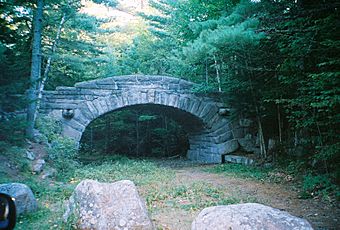Acadia National Park carriage paths, bridges and gatehouses facts for kids
Quick facts for kids |
|
|
Carriage Paths, Bridges and Gatehouses
|
|

Stone bridge at Bubble Pond, September 2005
|
|
| Nearest city | Bar Harbor, Maine |
|---|---|
| Built | 1919 |
| Architect | Grosvenor Atterbury |
| Architectural style | Tudor Revival |
| NRHP reference No. | 79000131 |
| Added to NRHP | November 14, 1979 |
Acadia National Park is a beautiful place on Mount Desert Island in Maine. A big part of this park was made possible by gifts from John D. Rockefeller Jr.. He loved the island but didn't want cars everywhere.
So, between 1919 and 1931, Rockefeller built a special network of roads. These roads were just for carriages, bikes, and walkers – no cars allowed! This network included 16 amazing granite bridges and two special gatehouses. Most of these paths are now inside Acadia National Park. They were added to the National Register of Historic Places in 1979 because they are so important.
Today, these carriage roads are open for everyone to enjoy. In summer, you can walk, bike, or even ride horses. When winter comes, they are perfect for cross-country skiing. Some parts are even open for snowmobiling.
Contents
Building the Carriage Roads
Mount Desert Island became a popular summer spot for rich families around 1890. Families like the Rockefellers, Carnegies, and Vanderbilts spent their summers here. They tried to keep cars off the island, but by 1915, cars were allowed everywhere.
John D. Rockefeller Jr. had a large summer home on the island. He decided to build his own network of roads. These roads would be separate from the public roads and offer amazing views. He personally chose the best builders for the roads, bridges, and gatehouses. He also watched over much of the work himself. The project lasted from 1919 to 1931.
A famous landscape designer, Frederick Law Olmsted, Jr., approved the overall plan. In total, over 50 miles (80 km) of roads were built. There were also 16 bridges and two gatehouses. These gatehouses were built in the Tudor Revival style. They marked where the carriage roads met public roads. Today, Acadia National Park includes about 47 miles (76 km) of these roads. It also has 13 of the original bridges and both gatehouses.
Exploring the Paths and Bridges
Carriage Paths and Bridges
The carriage paths are wide and follow the natural shape of the land. They offer stunning views of the lakes, mountains, and bays. Smaller footpaths branch off into the woods. The main carriage paths are about 16 feet (4.9 m) wide. The park service usually covers them with fine gravel. They are slightly raised in the middle to help rainwater drain away.
All the bridges are made from granite found right on the island. The stones were shaped by hand. These bridges were designed to blend in with nature. They are placed so you can enjoy the scenery from them. Sometimes, the bridges themselves are beautiful to look at. They often have special spots for viewing. Only one bridge, the Eagle Lake Bridge, has been changed much. It was widened in 1974 to carry Maine State Route 233 over a carriage path.
Special Gatehouses
There are two main gatehouses for the carriage road system.
Brown Mountain Gatehouse
The Brown Mountain Gatehouse is also called "The Lodge" by local people. It is near the park's southwest corner, close to Maine State Route 3 and Maine State Route 198. This small area includes the gatehouse, a caretaker's house, and a carriage house. Grosvenor Atterbury designed it in the Tudor Revival style.
The buildings are made of rough stone, with some neat rows of cut stone and brick. Their roofs are covered with colorful terra cotta tiles. The gates are made of cypress wood. They are set in a rounded archway. Like the Jordan Pond Gatehouse, this lodge is now used for park staff housing. Inside the gate, away from the main road, there is a large, beautiful lawn.
Jordan Pond Gatehouse
The Jordan Pond Gatehouse is at the south end of Jordan Pond. This is where the carriage paths meet the main park loop road. Atterbury also designed this gatehouse. It has similar features and style to the Brown Mountain Gatehouse. This gatehouse is laid out in a straighter line. Its parts are connected by a stone fence. The towers next to the gates have bell-shaped roofs with terra cotta tiles.
Images for kids





